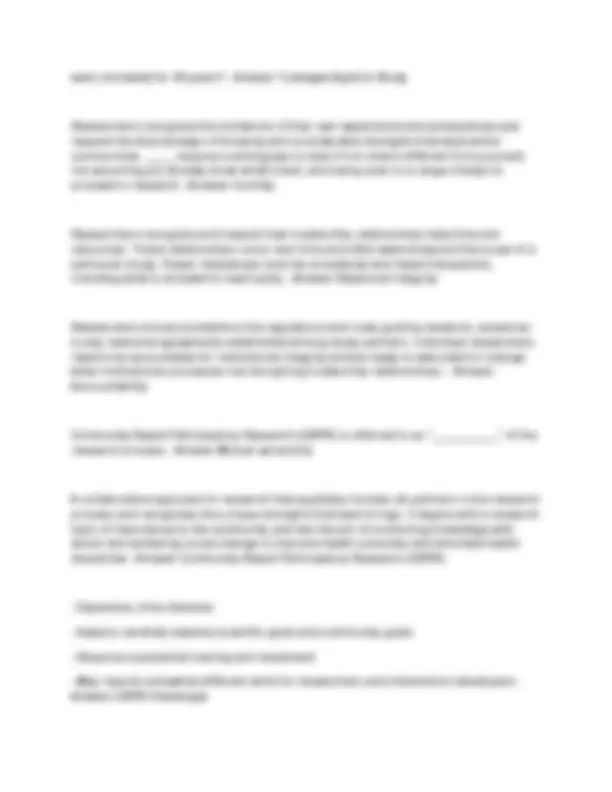








Study with the several resources on Docsity

Earn points by helping other students or get them with a premium plan


Prepare for your exams
Study with the several resources on Docsity

Earn points to download
Earn points by helping other students or get them with a premium plan
Community
Ask the community for help and clear up your study doubts
Discover the best universities in your country according to Docsity users
Free resources
Download our free guides on studying techniques, anxiety management strategies, and thesis advice from Docsity tutors
Key concepts in public health, including health disparities, risk and protective factors, and community-based participatory research (cbpr). It delves into the social determinants of health, examining how socioeconomic status influences health outcomes. The document also discusses the risk and protective factors model, highlighting the importance of understanding and addressing risk factors to promote positive health behaviors. Finally, it provides a comprehensive overview of cbpr, emphasizing its collaborative approach to research and its potential to address health disparities and improve health outcomes.
Typology: Exams
1 / 11

This page cannot be seen from the preview
Don't miss anything!







Healthy People 2020 states that _____ "a particular type of health difference that is closely linked with social, economic, and/or environmental disadvantage - Answer health disparities
McGill et al. (2015): Are interventions to promote healthy eating equally effective for all?
Examined whether healthy eating interventions have differential impact by socioeconomic status
Found that if they help high SES individuals more, interventions may actually _____ health disparities - Answer widen
McGill et al. (2015) coded studies with 6 Ps of social marketing - Answer Price
Place
Product
Prescriptive
Promotion
Person
Which of the 6 Ps was found to likely reduce inequalities by preferentially improving healthy eating outcomes in lower SES groups? - Answer Price
Which of the 6 Ps had less evidence but was found to more likely reduce inequalities? - Answer Place
Which of the 6 Ps did not have many studies and had mixed results? - Answer Promotion
Which of the 6 Ps had the highest number of studies and was judged most likely to increase inequalities? - Answer Person
What is referred to as interventions that target individuals? - Answer Downstream
What is referred to as interventions that target organizational structures and policies? - Answer Upstream
What model was developed by Hawkins, Catalano and colleagues and hypothesizes a predictive relationship between exposure to risk and protective factors and likelihood of a high-risk behavior? - Answer Risk and Protective Factors Model
Individual, peer, family, school, community, society/environmental are domains for... - Answer risk factors
Individual, social bonding, healthy beliefs, and clear standards for behavior are domains for... - Answer protective factors
Aggressive behavior, lack of parental supervision, substance abuse, drug availability, and poverty are all examples of.. - Answer risk factors
Self-control, parental monitoring, academic competence, anti-drug policies, and strong neighborhood attachment are all examples of... - Answer protective factors
In the risk and protective factors model, risk factors only _____ the likelihood of a high risk behavior - Answer increase
High-risk populations are populations who (give known risk factors) are at high risk for one or more.... - Answer health problems
"The worst part of repeatedly hearing your negative definition of me is that I begin to believe in myself, 'for as man thinketh in his heart, so is he.'" - Answer Eddie Ellis
Adults with schizophrenia
Children with autism
Individuals who use intravenous drugs - Answer People first language
Harm reduction approaches were developed to reduce the negative consequences associated with... - Answer drug use
What approach focuses on meeting people 'where they are at' and mitigating harm to promote overall public health? - Answer Harm reduction approaches
What has strong evidence for effectiveness in substance use? - Answer Harm reduction approaches
Hospitals, agencies, and programs are examples of... - Answer organizations
Healthcare systems, service systems, and policy coordination systems are examples of... - Answer systems
Organizations are viewed as ____ of human beings - Answer systems
Within organizational change, it is important to assess organizational... - Answer climate, culture, and capacity
_____ _____ has a goal of improving the capability of organizations and systems to respond to health issues - Answer Organizational Change
This is the purpose of the organization, its mission as understood by those in the organization - Answer Organizational Culture
Values and norms about how the mission is achieved, codes of behavior within the organization, other standards by which activity is measured - Answer Organizational
went untreated for 40 years? - Answer Tuskegee Syphilis Study
Researchers recognize the limitations of their own experience and perspectives and respect the diverse ways of knowing and considerable strengths that exist within communities. _____ requires a willingness to learn from others different from yourself, not assuming you already know what's best, and being open to a range of ways to proceed in research - Answer Humility
Researchers recognize and respect how trustworthy relationships take time and resources. These relationships occur over time and often extend beyond the scope of a particular study. Power imbalances must be considered and made transparent, including what is at stake for each party - Answer Relational Integrity
Researchers are accountable to the regulations and rules guiding research, as well as to any relational agreements established among study partners. Individual researchers need to be accountable for institutional integrity and be ready to advocate for change when institutional processes risk disrupting trustworthy relationships. - Answer Accountability
Community Based Participatory Research (CBPR) is referred to as "____________" of the research process - Answer Mutual ownership
A collaborative approach to research that equitably involves all partners in the research process and recognizes the unique strengths that each brings. It begins with a research topic of importance to the community and has the aim of combining knowledge with action and achieving social change to improve health outcomes and eliminate health disparities - Answer Community Based Participatory Research (CBPR)
T/F: Modern research and public health intervention designs often do not fall into the discrete categories of the traditional model vs. the CBPR model - Answer True
Which theory has a goal of generating theories that explain how some aspect of the social world works? - Answer Grounded theory
Grounded theory is often used to work towards _____ outputs - Answer quantitative
What method is used for analyzing data in order to develop a grounded theory? - Answer Constant comparative method
Increments of coding? (largest to smallest) - Answer Codes, categories, themes
What does PRECEDE stand for? - Answer Predisposing
Reinforcing
Enabling
Constructs (in)
Educational/Environmental
Diagnosis (and)
Evaluation
What does PROCEED stand for? - Answer Policy
Regulatory (and)
Organizational
Constructs (in)
Educational (and)
Environmental
Development
What phase of the PRECEDE PROCEED model assess the quality of life issues important to the community? - Answer Social Assessment
What are the 9 phases of the PRECEDE PROCEED model? - Answer 1. Social
Assessment
What phase of the PRECEDE PROCEED model assess health problem, comorbid conditions, and affected populations? - Answer Epidemiological assessment
What phase of the PRECEDE PROCEED model identifies the program goal and program objective? - Answer Epidemiological assessment
What phase of the PRECEDE PROCEED model asks what behavioral and environmental factors are associated with the health outcome and identifies sub-objectives and risk factors? - Answer Behavioral and environmental assessment
What phase of the PRECEDE PROCEED model identifies factors (predisposing, enabling, and reinforcing) which contribute to risks and also creates a plan to intervene on these factors? - Answer Educational and ecological assessment
Different level of risk factors in the PRECEDE PROCEED model? - Answer Individual, relationship, community, societal
What phase of the PRECEDE PROCEED model is the assessment of administrative, organizational, and political resources available (pro), it also identifies staff, equipment, facilities, and funding that you will need? - Answer Administrative and policy assessment
Process evaluation: Were you able to recruit your target population? - Answer Assessing Reach
Process evaluation: Was the intervention delivered as intended? - Answer Assessing Fidelity (assessing contamination)
What type of evaluation evaluates the process of implementing an intervention? - Answer Process evaluation
What does process evaluation assess? - Answer Change (proposed mechanism), fidelity, reach
Within outcome evaluation, success must be... - Answer pre-determined
Key factors to consider in _____ evaluation:
Measurement methods
Clinically significant cut-offs
What is success? - Answer Outcome
What evaluation addresses this question:
What are the long-term impacts of the intervention? - Answer Impact evaluation
Community level assessments as well as long-term follow up assessments are examples of... - Answer Impact evaluation
What does RE-AIM stand for? - Answer Reach
Efficacy/Effectiveness
Adoption
Implementation
Maintenance
Inputs (resources)
Activities
Outputs
Outcomes
Impacts - Answer Key Components of a Logic Model